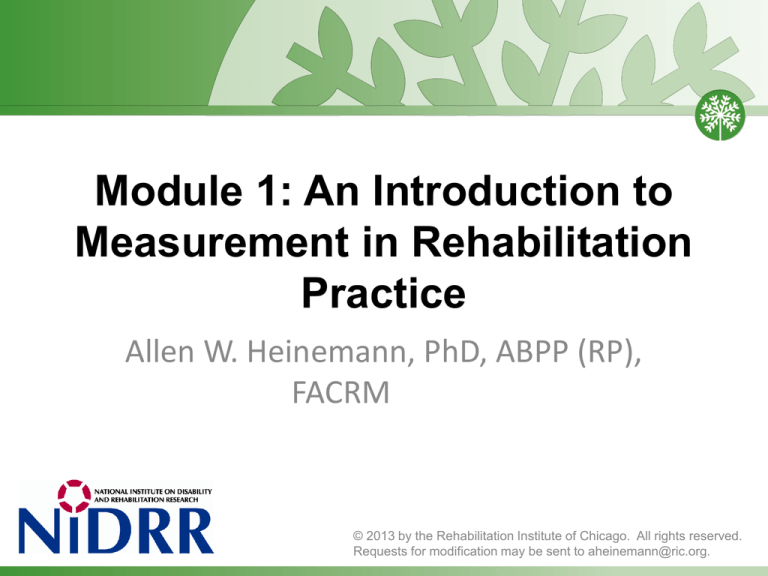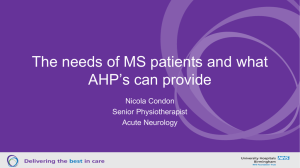
Module 1: An Introduction to
Measurement in Rehabilitation
Practice
Allen W. Heinemann, PhD, ABPP (RP),
FACRM
© 2013 by the Rehabilitation Institute of Chicago. All rights reserved.
Requests for modification may be sent to aheinemann@ric.org.
Course Objectives
The learner will be able to…
1. Recognize the value and importance of using classification
schemes and outcome measures to evaluate of Body Function
and Body Structure, Activity, and Personal, and Environmental
Factors that influence Participation.
2. Evaluate, interpret, and document client goals and outcomes in
clinical practice using a client-centered approach.
3. Increase one’s capacity to effectively utilize resources to assist
with outcome measure selection, including the use of online
databases to find assessment tools and interpret their
measurement properties.
Course Objectives, continued
4.
5.
6.
7.
Critically evaluate measurement properties of existing outcome
measures for application in clinical practice, including validity,
reliability, responsiveness, and clinical utility.
Identify strategies to facilitate the use of outcome measures in
clinical practice.
Identify strategies to overcome common barriers to implementing
outcome measurement in clinical practice.
Effectively sustain outcome measurement use across his or her
practice, and across practice sites or programs.
Course Outline
Module 1
Introduction: Why Measure?
Objective 1: Classification Systems
Module 2
Objective 2: Interpret and
document outcomes in clinical
practice
Objective 3: Facilitate skills to
access web-based databases
and to select measures
Module 3
Objective 4: Measurement
properties
Module 4
Objective 5: Strategies to facilitate
use of measures
Objective 6: Strategies to identify
and overcome barriers
Objective 7: Sustaining
measurement in practice
Course Audience
•
Rehabilitation Professional Students/Trainees
– Physical Therapy
– Occupational Therapy
– Speech and Language Pathology
– Nursing
– Recreational Therapy
– Physiatry
– And other disciplines serving rehabilitation
patients
Module I: Introduction
1. Definitions
2. Benefits of measurement
3. Barriers to measurement
4. Outcomes classification system
(ICF)
1. Definitions
•
What is an outcome?
– A measurable individual, family, or community state, behavior or perception that is
measured along a continuum and is responsive to clinical interventions.
•
What is an outcome measure?
– A set of items that are used to create scores that are “intended to quantify a patient’s
performance or health status based on standardized evaluation protocols or close
ended questions.” (Jette, Halbert, Iverson, Miceli, Shah, 2009)
•
Why measure patient characteristics using standardized
outcome instruments?
–
–
–
–
Documentation in electronic records
For use in clinical information systems
For the development of clinical knowledge and professional education
Resource allocation and accountability
(Johnson, Maas & Moorhead, 2000)
In patient care, outcome measures help:
• Establish a patient’s baseline status
• Track a patient’s progress to determine the effectiveness of the
•
•
•
plan of care
Inform patients of their progress in a quantifiable manner
Inform payers of patient progress to enhance reimbursement
Provide data collected over time to improve care
2. Benefits of Outcome Measurement
Individual
Health
Professionals
Clinical Decisions & Competence
Communication
Colleagues/
Referral Sources
Group/
Organization
Accountability
Efficiency
Patients
Communication & Engagement
Effectiveness
Insurers/Payers
Communication & Claim decisions
Value
Scientists
Evaluate clinical trial benefits
Effectiveness
(Swinkels 2011, Jette 2009, Finch 2002, Kay 2001, Cole 1994)
Facilitators of Outcome Measurement
Individual Practioners
• Positive attitude: to measurement and change, convinced of benefits
• Flexibility: room for personal considerations
• Practicality: immediacy, negotiate with insurers, quality improvement
• Consistency of treatment
External
• Access to resources about a range of measures
• Support: from colleagues (opinion leaders) and organization
• Guidance in selection, administration, scoring, and interpretation
(Swinkels 2011, Jette 2009, Finch 2002, Kay 2001, Cole 1994)
3. Barriers to Outcome Measurement
•
Individual
– Time: to search, administer, score, interpret
– Knowledge: to select, interpret
– Resources too few available, too many to choose, difficult to set up,
equipment required, unclear instructions, difficult to interpret
– Competence: education, routine, experience
– Attitude: belief that outcome measures are unnecessary, skepticism,
feeling overwhelmed, lack confidence in use
•
Organizational
–
–
–
–
Time and Cost: investment required, no compensation
Policy: no policy, poor adherence/compliance
Culture: congruence/conflict at micro and macro levels
Lack of consensus: No guidance from professional or advocacy groups
(Swinkels 2011, Jette 2009, Finch 2002, Kay 2001, Cole 1994)
4. Outcomes Classification System
International Classification of
Functioning, Disability and Health
International Classification of
Functioning Disability and Health
Body Functions
&
Structures
Activities
&
Participation
Environmental
Factors
Functions
Capacity
Barriers
Structures
Performance
Facilitators
http://apps.who.int/classifications/icfbrowser/
Interactions Among ICF Components
Health Condition
(disorder or disease)
Body Function
& Structures
Activity
Environmental
Factors
Participation
Personal
Factors
http://www.who.int/classifications/icf/en
Body Functions and Structures
•
Body Functions
–
–
–
–
–
–
–
–
•
Chapter 1 Mental Functions
Chapter 2 Sensory Functions and Pain
Chapter 3 Voice and Speech Functions
Chapter 4 Functions of the Cardiovascular, Hematological, Immunological and Respiratory Systems
Chapter 5 Functions of the Digestive, Metabolic, and Endocrine Systems
Chapter 6 Genitourinary and Reproductive Functions
Chapter 7 Neuromusculoskeletal and Movement-related Functions
Chapter 8 Functions of the Skin and Related Structures
Body Structures
–
–
–
–
–
–
–
–
Chapter 1 Structures of the Nervous System
Chapter 2 The Eye, Ear and Related Structures
Chapter 3 Structures Involved in Voice and Speech
Chapter 4 Structures of the Cardiovascular, Immunological and Respiratory Systems
Chapter 5 Structures Related to the Digestive, Metabolic, and Endocrine Systems
Chapter 6 Structures Related to the Genitourinary and Reproductive Systems
Chapter 7 Structures Related to Movement
Chapter 8 Skin and Related Structures
Activities and Participation
•
Activities and Participation
–
–
–
–
–
–
–
–
–
Chapter 1 Learning and Applying Knowledge
Chapter 2 General Tasks and Demands
Chapter 3 Communication
Chapter 4 Mobility
Chapter 5 Self-care
Chapter 6 Domestic life
Chapter 7 Interpersonal Interactions and Relationships
Chapter 8 Major Life Areas
Chapter 9 Community, Social and Civic Life
Environmental Factors
• Chapter 1 Products and Technology
• Chapter 2 Natural Environment and Human-Made Changes to
•
•
•
Environment
Chapter 3 Support and Relationships
Chapter 4 Attitudes
Chapter 5 Services, Systems and Policies
Outcome Measures Across the ICF
•
Outcome measures exist
across the ICF levels
– This enables health care
professionals to quantify
the various ways a health
condition impacts an
individual and assures a
comprehensive approach
to patient care
•
Body function and structure
– Mini Mental Status Examination: a
screening tool for cognition
•
Activity
– Functional Independence Measure:
used in inpatient rehabilitation
facilities to measure a variety of
functional tasks and capabilities
•
Participation
– Community Integration
Questionnaire: a self-report
measure of role function and
community interaction
Summary Review
•
•
•
•
•
•
What is an outcome measure?
Why measure patient characteristics using standardized
outcome instruments?
What are the benefits of outcome measurement using
standardized instruments?
What are some barriers to outcome measurement?
What facilitates outcome measurement?
What classification systems are available to guide
thinking about outcomes?
Questions and
Discussion
Project Staff
• Allen Heinemann, PhD – Director of CROR, at Rehabilitation Institute of Chicago,
•
•
•
•
•
•
Northwestern University PM&R
Joy Hammel, PhD, OTR/L, FAOTA – Professor, Occupational Therapy and Disability
Studies, University of Illinois at Chicago
Carolyn M. Baum, PhD, OTR/L, FAOTA – Professor, Occupational Therapy, Neurology
and Social Work, Washington University School of Medicine
Jennifer Moore, PT, DHS, NCS – Clinical Practice Leader, Neurological Physical
Therapy, Rehabilitation Institute of Chicago
Jennifer Piatt, PhD, CTRS – Assistant Professor, Recreational Therapy, Public Health,
Indiana University
Kirsten Potter, PT, DPT, MS, NCS – Associate Professor, Physical Therapy, Rockhurst
University
Jillian Bateman, OTD/OTR/L, CCRC – Project Manager, CROR Rehabilitation Institute
of Chicago
Project Contributors
•
•
•
•
•
Anne Deutsch, PhD – Clinical Research Scientist, Rehabilitation Institute
of Chicago
Richard Gershon, PhD – Professor and Associate Chair, Medical and
Social Sciences, Northwestern University
Allan Kozlowski, PT, PhD – Clinical Research Scientist, Mt. Sinai School
of Medicine
Jason Raad, PhD – Project Manager, CROR, Rehabilitation Institute of
Chicago
Kathleen Stevens, PhD RN –Nursing Education, Rehabilitation Institute
of Chicago, Northwestern University PM&R
References
•
•
•
•
Jette DU, Halbert J, Iverson C, Miceli E, Shah P. Use of
standardized outcome measures in physical therapist practice:
perceptions and applications. Phys Ther 2009; 89:125-135.
Johnson, Maas & Moorhead (Eds). Nursing Outcomes
Classification (NOC). 2nd ed. St. Louis: Mosby Kay; 2000.
Swinkels RA, van Peppen RP, Wittink H, Custers JW, Beurskens
AJ. Current use and barriers and facilitators for implementation of
standardized measures in physical therapy in the Netherlands.
BMC Musculoskelet Disord 2011 May 22; 12:106.
Finch E, Brooks D, Stratford P, Mayo, N. Physical rehabilitation
outcome measures. 2nd ed. Hamilton: BC Decker; 2002.
References
•
•
•
Kay T, Myers A, Huijbregts M. How far have we come since
1992? A comparative survey of physiotherapists' use of outcome
measures. Physiother Can 2001; 53(4):268-275.
Cole B, Finch E, Gowland C, Mayo, N. Physical rehabilitation
outcome measures. Ontario: Canadian Physiotherapy
Association; 1994.
Moore J., Raad J, Ehrlich-Jones L, Heinemann AW. Development
and Use of a Knowledge Translation Tool: The Rehabilitation
Measures Database, Archives of Physical Medicine and
Rehabilitation, in press.
Copyright Information
© 2013 by the Rehabilitation Institute of Chicago. This work is
licensed under a Creative Commons license at
http://creativecommons.org/licenses/by-ncnd/3.0/deed.en_US. You are free to copy, distribute, and transmit
the work, subject to the conditions listed in the license. For
permission to modify this work or to use it for commercial purposes,
please e-mail Allen Heinemann at aheinemann@ric.org.
Help us improve…
Thank you for downloading the Outcomes Measurement
Educational Modules. Please help us enhance and improve this
resource by completing our short (10 minute) survey:
https://www.surveymonkey.com/s/B685Q85
Thank you!











